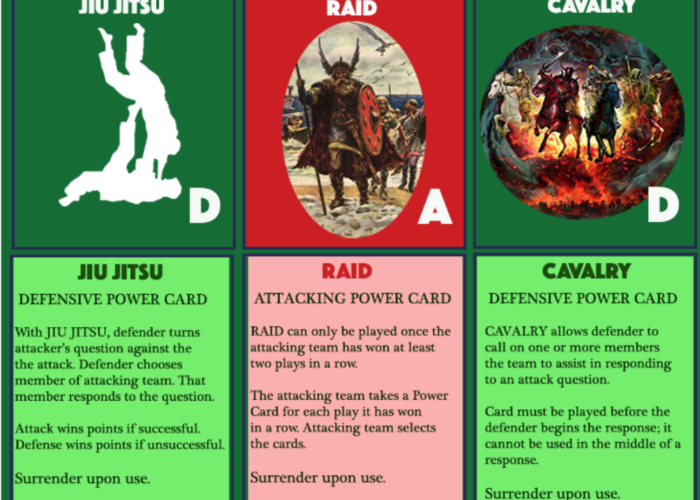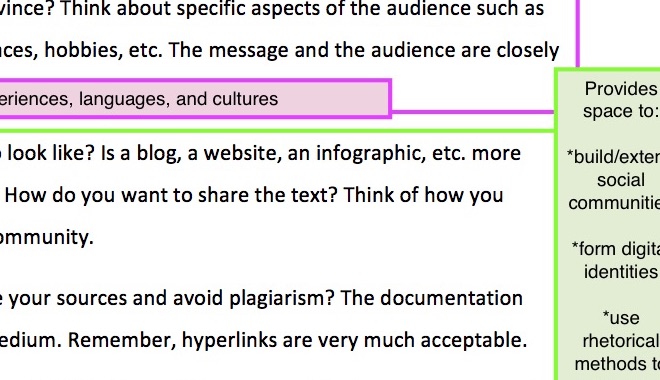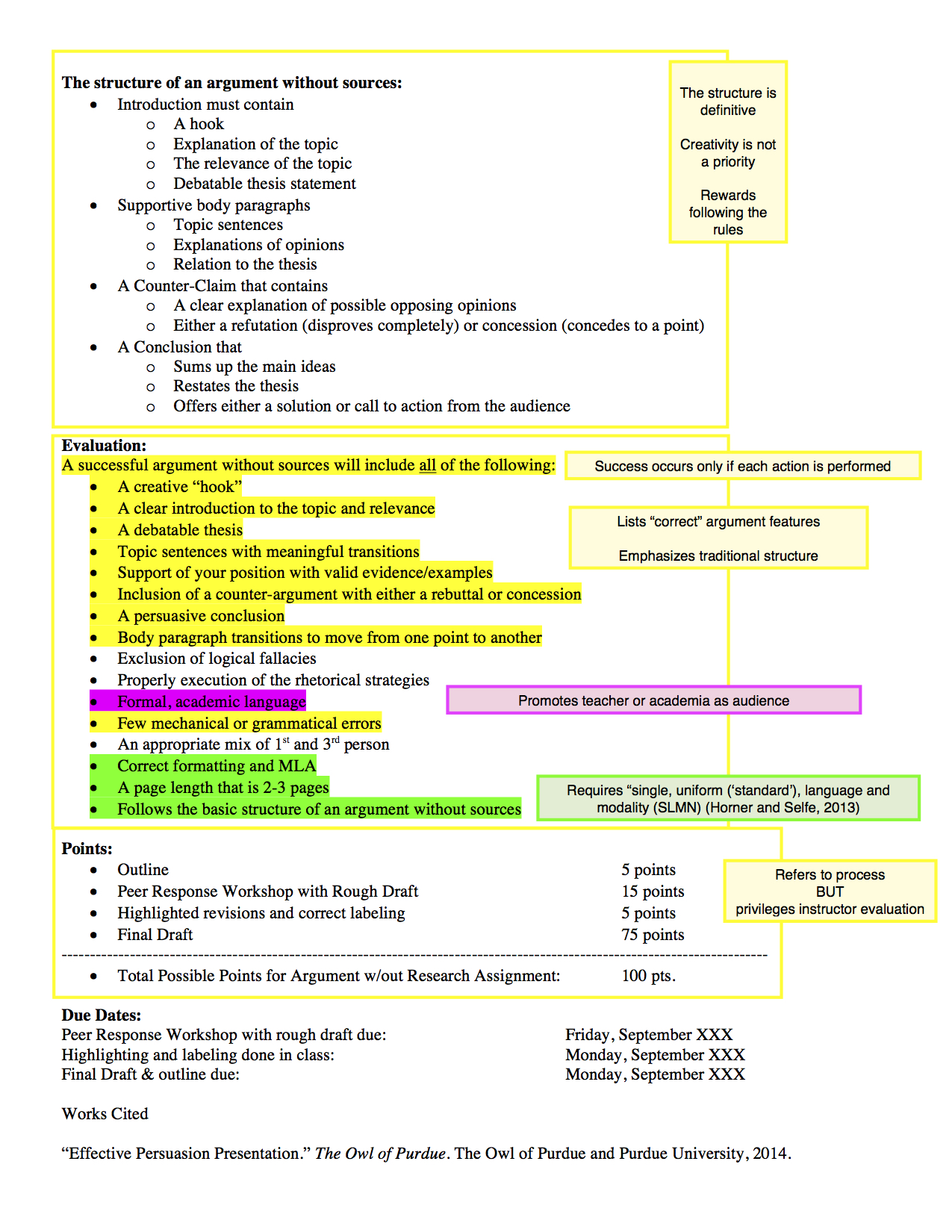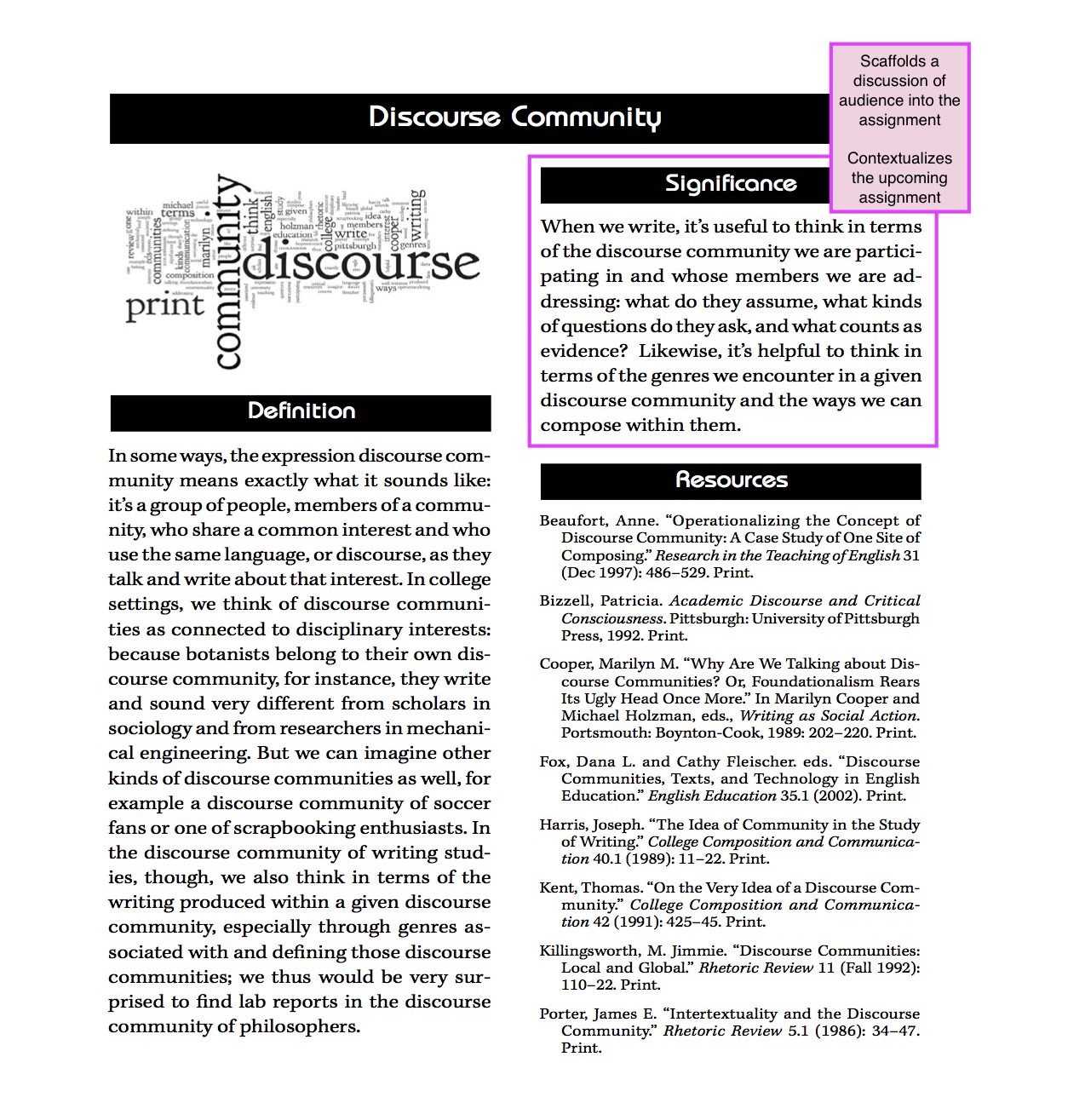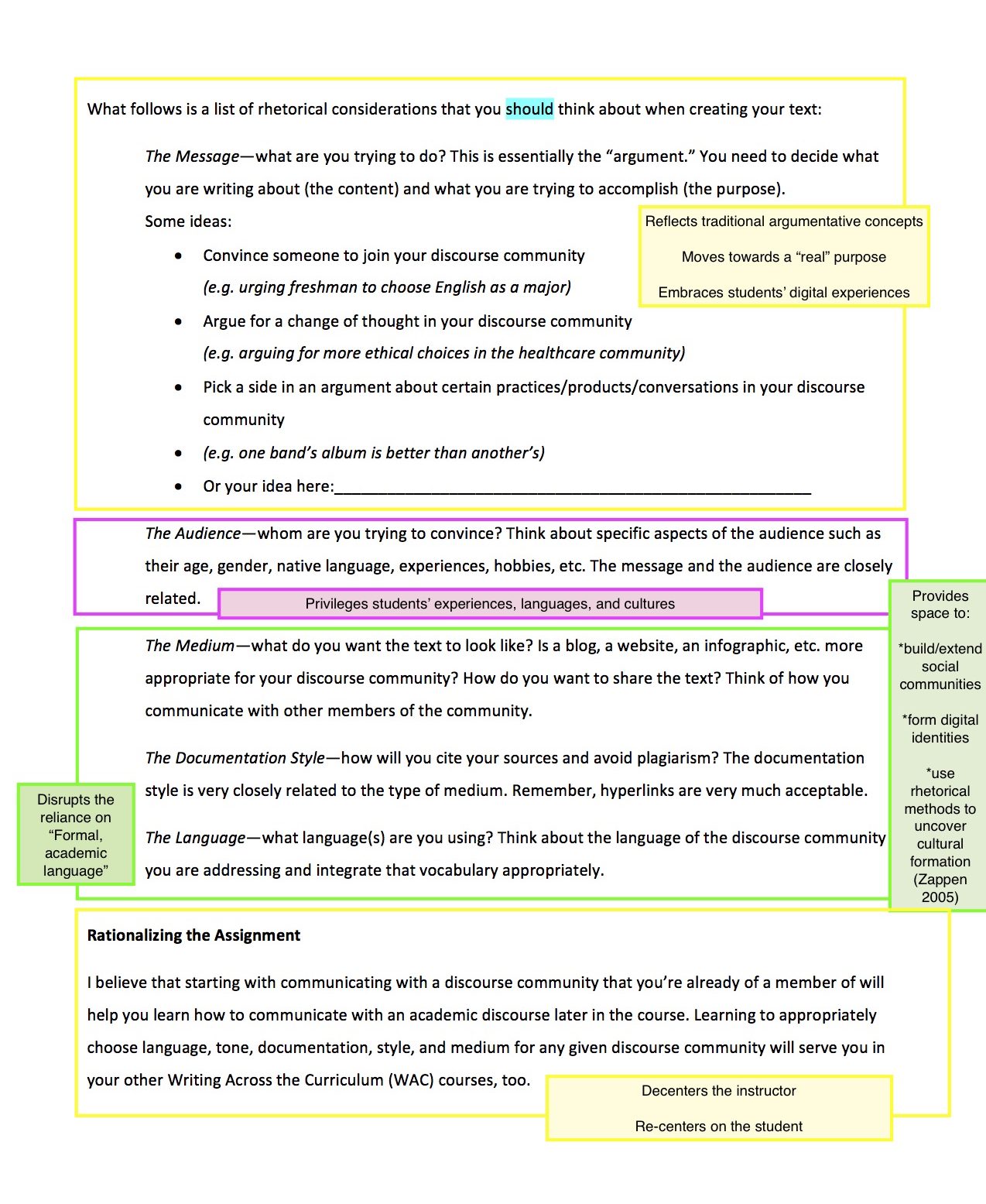Introduction
Although multimodal composition assignments and the use of digital tools have become common in First-Year Writing (FYW) courses, many curriculums and assignments still require students to produce at least one traditional essay targeted to an academic audience using academic language. As a FYW instructor, I have witnessed students’ anxiety related to writing academically for college audiences; however, more recently, I believe this apprehension has grown. Possibly the proliferation of standardized high school writing curriculums and the continuous push for high school teachers to “teach to the test” have made writing academically even less relatable for incoming students than it has been in the past. High school writing assignments that require students to respond to prompts or follow a strict set of guidelines may not prepare students adequately to respond to collegiate writing situations that call for students to address an academic audience.
College writing assignments that ask students to write to an “academic audience,” which reflects Ede and Lunsford (1984)’s “invoked” audience, may further compound students’ apprehension related to writing at the college level. Invoking an audience requires students to imagine and construct their audience, and can be difficult for emerging or even practiced writers. Even when writing instructors do provide students with a specific audience within a writing assignment, it is probable that this “audience” will likely be conceptualized by the student as his or her teacher. This “writing to the teacher” frame of mind often results in students guessing how to address their audience, which hinders their ability to write academically.
Assignments that direct students to write to an imagined academic audience will most likely reflect current-traditional rhetoric (CTR) practices, which emphasize product, usage, style, and form (Berlin and Inkster 1980). When this emphasis becomes the basis for a writing assignment, it inhibits students’ creativity, promotes the binary of “good” or “bad” writing, and requires instructors to evaluate students on how well they can imitate traditional academic writing conventions. Though researchers and teachers have recognized that relying solely on CTR in writing assignments does not ensure, and may seriously hinder, students’ ability to recognize and converse with academic discourse communities (Werner 2017), remnants of or in some cases outright adherence to CTR still exist in many common FYW assignments. CTR is evident in assignments that require students to use proper MLA or APA documentation, correct grammar and mechanics, a regulated number of researched-based sources, and academic language. These types of assignments also generally rely on what Horner and Selfe (2013) call “single, uniform (‘standard’) language and modality” or SLMN, which results in a final product that has homogenized students’ language due to the required use of academic English and has been written using a word processor, printed, and handed to the teacher for evaluation.
I suggest incorporating digital rhetoric as a conceptual composing framework (Eyman 2015; Zappen 2005) to problematize CTR practices, SLMN requirements, and a continued tradition of teaching students to write for an academic audience. Using digital rhetoric as a framework creates an environment for multimodal composition practices, which provide opportunities for students to engage with “real” audiences. Even though many writing instructors and programs have answered calls from the field (Yancey 2009) and integrated multimodal assignments into writing curriculums, they are sometimes treated as a less-than-important assignment compared to traditional writing assignments. While these assignments may be integrated to meet programmatic digital literacy requirements, multimodal assignments are often placed last in a sequence of assignments in writing curriculums and are often associated with a “fun” or motivating end of semester composition anomaly. While I am not suggesting that all multimodal assignments receive such curricular placement or act only to engage or motivate students (Takayoshi and Selfe 2007), I am urging more instructors to recognize that multimodal composing in digital environments is also a rigorous academic endeavor.
This paper argues that using digital rhetoric to integrate multimodal composition assignments disrupts academic conventions perpetuated by the still prevalent CTR paradigm while also helping students write to real audiences, rather than the loosely imagined “academic audience.” I also discuss my use of digital rhetoric as an analytic method (Eyman 2015) to analyze a traditional assignment I have used in past FYW classrooms. Based on that analysis, I revised the assignment to embrace digital and multimodal affordances and disrupt academic writing conventions.
Analyzing a Traditional FYW Assignment: An Argument Without Sources Essay
Background
As a FYW instructor at a four-year university located in an urban setting, I have encountered traditional writing assignments that rely on CTR and SLMN. These assignments are part of the writing program’s curricular focus on classical rhetorical concepts and traditional argumentative structures. This curriculum promotes academic rigor and opportunities for students to practice academic writing but it also reinforces teacher-centered pedagogy and rewards students who can follow the rules of academic writing. One assignment I found particularly problematic was the “Argument Without Sources Assignment,” even though I co-wrote the assignment sheet in 2013. The assignment is the first of four in a shared assignment sequence in the program’s College Writing II course, which focuses on information literacy and argumentative writing and likely parallels other writing assignments found in various FYW curriculums across the country.
Knowing that I wanted to revise the traditional assignment, I first analyzed it using digital rhetoric and student-centered pedagogical philosophy. The result of my analysis is a color-coded visual analysis of the assignment (see Appendix A for the full assignment sheet) pointing out areas that adhere to CTR through language (blue) and content (yellow), requirements that perpetuate the production of SLMN texts (green), and sections that provide only vague references to audience (pink). In the following discussion, I have included screenshots of annotations made to the original visually annotated assignment sheet to support my argument that the assignment (and ones like it) still reinforce the CTR paradigm and the production of monomodal texts.
Instructor Language Usage and Textual Design in a Traditional FYW Assignment
The original “Argument Without Sources” assignment uses imperative language that promotes teacher-centeredness and decenters the agency of the student. Figure 1 shows that “must” is used five times and “will” is used twice in the span of five sentences. An overall authoritative tone maintains the feeling that a student cannot negotiate with academic conventions but should conform to the expectations of the teacher, program, or university. The relationship that this type of language use creates is also one based on authority rather than dialogue. The use of “must” solidifies the teacher as the giver of knowledge and the student remains the receiver. This problematic dichotomy may look shockingly familiar to many instructors.
Even the assignment sheet’s formatting maintains that dichotomy. The font, font size, and spacing are severe and intimidating. Students literally “see” the authority of the instructor in the use of small margins and a lack of white space. The design does not take into account how a student might read it; rather its purpose is to identify requirements and rules. The design is unfriendly to transitioning writers and perpetuates the myth that “good” writing must look a certain way.

Production of a Standard, Normal, and Monomodal Text
The green highlighted phrases in Figure 2 indicate that print-based design and dissemination is privileged. The “Evaluation” section declares that a successful text must have “correct formatting and MLA [and] a page length that is 2-3 pages.” Here, students are being explicitly asked to produce a print-based essay following the conventions of MLA style. Though I am not arguing for the removal of documentation requirements or the print-based essay, I do believe these stringent and non-contextualized requirements reduce students’ agency and increase focus on product rather than process. Perhaps if there was more emphasis on avoiding plagiarism rather than emphasizing the need to “correct” formatting and documentation, then students might begin to understand that a writer’s choice of documentation style signifies a connection with a discipline-specific audience.

Whom Am I Addressing?
In the traditional assignment, the word “audience” is mentioned once and is only implicitly referred to later in the “Evaluation” section (see pink annotations in Appendix A). The assignment declares that students must “address an audience” using “ethos, pathos, and logos.” This statement does not allow students to clearly envision a real or easily construct an imagined audience and implies that they should simply write for the instructor. The lack of audience specificity adheres to the prevalent “teacher as audience” conceptualization of audience and does not disrupt the problematic nature associated with asking students to write academically.
The “Evaluation” section also lists the use of “formal, academic language” as a requirement to produce a successful argument. Not only is this assessment criteria reinforcing CTR, but also some students may not have experience with this type of language or know when to use it. Further, if students do not have a concrete audience to address or if they cannot clearly imagine an audience based on their experiences, then asking them to use formal, academic language may prove especially frustrating for them.
Perpetuating the Current-Traditional Rhetoric Paradigm
The last aspect of the assignment sheet, annotated in yellow, is a broader categorization of foregrounding teacher, program, or university expectations rather than the students’ own experiences and languages. Again, the “Evaluation” section states, “a successful argument will include all of the following requirements.” The focus here is on what students “must” include to complete the assignment and achieve a high score. There is little room for negotiation between the instructor and the student and clearly values the product rather than the process. Though there are references to process writing, specific points and due dates are also included taking away from the recursive nature of the writing process and revision.
Figure 3 shows a list of specific features of argumentative writing (e.g. an introduction, body paragraphs, etc.), which might be useful to new writers. However, the highly specific bullet points within each section seemingly imply that students should check provided argumentative features off the list as they write–possibly impeding their writing processes and promoting commonality among a diverse group of students. This promotion of commonality in writing also reinforces the problematic binary that there is a “right” way to write and only if a student performs as they are told, can he or she achieve success.

While using this assignment in my courses, I quickly became frustrated because it forced students to produce essays that looked and sounded the same. The argumentative structures were repeated, student voices became homogenized, and, because students were forced to use their textbook as the basis for their arguments, the content was also very similar. After reading nearly 200 of these papers over the course of two academic years, I decided to begin embracing digital rhetoric and multimodal composing practices. Although there were challenges associated with integrating an assignment reflecting these practices and digital rhetoric, I argue that the revised assignment discussed below achieved the same course goals, encouraged creativity and agency, and taught students how to recognize and converse with various discourse communities.
A Discussion of the Revised Assignment: Convincing your Discourse Community
Using the same color coding method, I created a visual analysis of the revised assignment (see Appendix B). In this version, areas of negotiation and less imperative language are highlighted in blue, revisions to prescriptive requirements and teacher-centered pedagogy are annotated in yellow, integration of digital rhetoric is annotated in green, and specific references to audience are annotated in pink. The revision was implemented into my four sections of College Writing II in the spring of 2017. Like the original, students produce a persuasive text as the first assignment in the course sequence, but the revision asks students to choose one of their discourse communities (e.g. a video gamer community), determine an argument intended for that community, compose their text multimodally, and share it digitally with the community.
Assignment Sheet Design and Language
Design
When designing the assignment sheet, I attempted to make the format less intimidating and easier to read. I enlarged both the font size and spacing, which makes the text look less intimidating. I also used Calibri as a font, rather than Times New Roman, because it is not as commonly associated with traditional academic writing. However, I feel that the assignment sheet itself could (and should) be revised to include multiple modes rather than relying completely on changes to font, spacing, and white space.
An additional “poster” from NCTE (2012) was included to provide an entry point for students beginning to learn about discourse communities and shows that disrupting traditional, scholarly formats is appropriate in context. Many students may feel that to “write academically” one must produce a text that looks academic. The NCTE text problematizes this notion and gives students a multimodal example of work created by a highly respected academic organization.
The text can also serve as the basis for discussions about the relationship between context and design. For example, an instructor might facilitate a discussion about how to determine when a text should reflect academic design conventions and when a less traditional design might also be appropriate.
Language
In Figure 4, words highlighted in blue show the revision of declarative statements such as “students must” to more negotiated language such as “you should” or “this assignment asks you to…” I believe shifting from restrictive language provides students with the opportunity to reflect on, question, or negotiate with the assignment or the instructor rather than simply follow the directions.

Embracing Digital Rhetoric and Producing a Multimodal Text
In Figure 5, the green highlighting points out instances where the assignment asks students to shift from traditional composing practices to multimodal and embrace the affordances of digital environments. The revised assignment requires students to compose multimodally and share their work online with the appropriate discourse community.
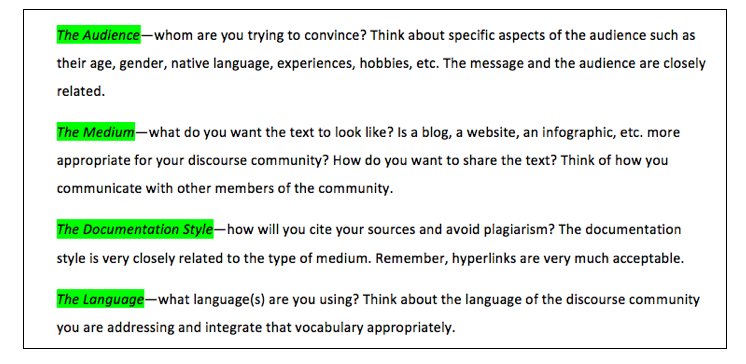
Recognizing that not all students are comfortable with multimodal design, students have the choice to create more print-based texts such as posters or newsletters, but they are still asked to compose multimodally and share those texts with their discourse community online. This aspect of the assignment combines digital environments with traditional rhetoric, which allows students to account for their audience and medium when choosing appropriate rhetorical moves (Eyman 2015; Zappen 2005). This helps students think more about the power of visual, aural, gestural, and spatial modes of communication when constructing an argument as opposed to considering only the linguistic mode and print-based production options.
Addressing a Real and Interactive Audience
When contrasting traditional print affordances and multimodal affordances, the latter provide students with more opportunities to communicate with varied and interactive audiences. Research has shown that students perceive audience awareness as an affordance of multimodal composing (Alexander, Powell, and Green 2012; Kirchoff and Cook 2016; Takayoshi and Selfe 2007). The revised assignment places audience awareness at the center of its pedagogical goal, rather than relying on a vague description of an imagined audience. Pink annotations showcase areas where audience is prioritized (see Appendix B for full annotations), beginning with the poster from NCTE that defines discourse communities and scaffolds understanding of discourse communities into the assignment. Figure 6 shows a disruption of the traditional notion of a teacher as audience by asking students to first visualize an imagined audience, based on their actual experience(s), then to write to those audiences by digitally sharing the texts with their communities. Shifting from vague audience conceptualizations to real and interactive ones aligns with two of the primary activities within a digital rhetoric framework: helping students form digital identities and building social communities (Zappen 2005).

Asking students to share their work online embraces the affordances offered by writing in digital environments using digital tools (Nobles and Paganucci 2015). However, this choice was not without its challenges. Generally, students appreciated the opportunity to directly interact with an audience of their choice, but some students were not as comfortable with this component. Prior to the actual dissemination of their texts, some students requested that they be allowed to use fake names or to remove their work as soon as I had evaluated it. Students were quickly granted permission for their requests, but I recognize the gap in execution of the assignment. To account for this gap, I plan to scaffold lessons into the project that help students choose how they want to be (de)identified. I will also create an option for students to post their work to a shared and closed classroom website designed and curated by me.
Shifting the Focus from CTR
The revised assignment upholds the programmatic goal of requiring students to produce a persuasive text, but yellow annotations illustrate areas that allow for student creativity and playfulness. The “Evaluation” section, while still in a list form, has been shortened considerably and the criterion for success has been expanded. The revised assignment does not require “formal, academic voice”, which gives students more room to express themselves and use varied and rhetorically appropriate languages, dialects, and slang based on the discourse community they are addressing. However, the streamlined evaluation section creates a challenge related to creating an effective assessment tool. When assessing a student’s work, I need to act as both the evaluator and as hypothetical audience-member, which is challenging. Since the assignment was created to reinforce the components of digital rhetoric and allow for student creativity, I believe that my primary job is to act as a hypothetical audience-member and respond accordingly.
Although this may put more pressure on the instructor, it helps shift the assessment of student work from evaluating how well a student demonstrates his or her ability to write academically (privileging commonality) to one that evaluates how well a student uses languages and various modes to effectively address his or her community (promoting difference).
One potential benefit of the assignment is its ability to prepare students for responding to writing situations in other courses by not giving them a specific rhetorical situation. Instead, it urges them to really think about who they are as an author and as a member of that community, the message that they want to share within the context of that community, and to address a “real” community that they know from experience. This does not mean that some students do not choose to address a more formal community (e.g. a workplace manager) but it gives them the choice to do so. The point of this assignment is not to reinforce the importance of grammar, MLA, or academic voice (though those are important components of their final semester project) but to introduce them to the idea of discourse communities as audience and to think about composing in a digitalized world.
Student Reception of the Revised Assignment
When I incorporated the revised assignment into my course in spring 2017, I was nervous that students would push back against the lack of formalized instruction and that they might not see the connection between their discourse communities and writing persuasively. For the most part, I was happily surprised. I witnessed students who initially identified themselves as “terrible” writers spending hours on revising their website layout to “make it easier for my discourse community to understand.” One specific example stands out. A self-proclaimed “bad writer” from day one, Sue was hesitant about the class. When told that she would not be writing a formal essay as the first assignment, she became a little less hesitant. When told she could choose her audience, use language of that community, and share her message with them, she was absolutely thrilled. Two and half weeks later, she produced a website convincing a specific audience, the discourse community of avid golfers, to play at her favorite golf course. She included tabs echoing the traditional argumentative essay structure as well as an “author bio” tab, which she explained helped “get her credibility with her audience.” For the remainder of the semester, she was confident in her writing skills. She spent more time revising her traditional text than she had in other writing classes (according to her) and she became an active member in our small classroom community.
The example I have shared is just one of many positive experiences I had with this assignment last semester, but that is not to say that there weren’t less-than-positive experiences. As stated previously, some students were uncomfortable with sharing their work online, while others struggled with the skills associated with creating a text using digital tools. Some students struggled to create functional websites and some had difficulties converting a text-based document into a format that could easily be shared online. While I attempted to account for these struggles via mini-technology lessons, more time should have been spent discussing problem-solving strategies to aid students in the creation and dissemination of their texts. These strategies might include prompting students to create a list of places to find help on campus and useful web-based tools (e.g. tutorials, freeware, examples, etc.), which would be shared on our online course management system.
Some students also felt that a multimodal composition assignment was not preparing them academically and disliked the non-traditional nature of the assignment. Yet, generally and anecdotally speaking, many students began to see that writing does not always have to look and sound the same and that there is room for creativity in academic writing. They also began to understand that “audience” does not simply mean writing to one’s teachers. This assignment also made it easier for me to introduce academic discourse communities to my students, which helped them think about a discipline-specific academic audience when they chose topics, journal articles, documentation styles, and language prior to and during the writing of their final research papers (a traditional, print-based assignment). My assertion is that framing a multimodal assignment using digital rhetoric helps teach students how to recognize the connection between audience, message, and digital environments. This kind of digital rhetorical work might also help shift the multimodal and digital assignment from “lesser than” to “equal to” or “as good as” traditional, print-based composing.
Final Remarks
My discussion here offers a revision of what I saw as a restrictive assignment that closely adhered to CTR. While I am not claiming that digital rhetoric and/or digital practices should replace traditional print-based composing practices, I am urging instructors to consider incorporating digital rhetoric into their curriculums to continue to provide opportunities for student choice and creativity. This paper showcased my willingness to use digital rhetoric as an analytic tool to analyze and then revise a common writing assignment in my FYW classroom. I also urge any instructor who wishes to push against the CTR paradigm of academic writing, which often leaves out varied and textured voices, to conduct a similar analysis of a traditional assignment and then revise it so it reflects a digital rhetoric framework. I hope that fellow instructors who have become frustrated with the vague instructional goal to teach students “audience awareness” will consider the affordances provided by digital spaces and help students learn (re)address real and interactive online communities.


